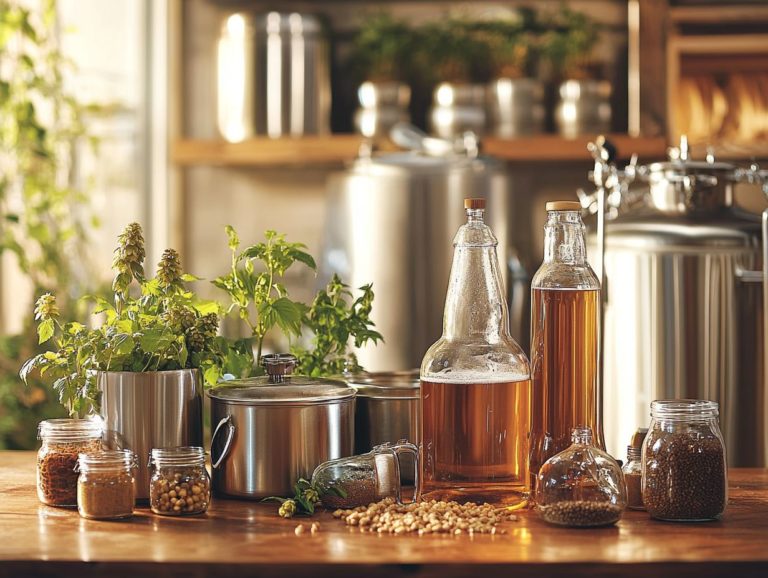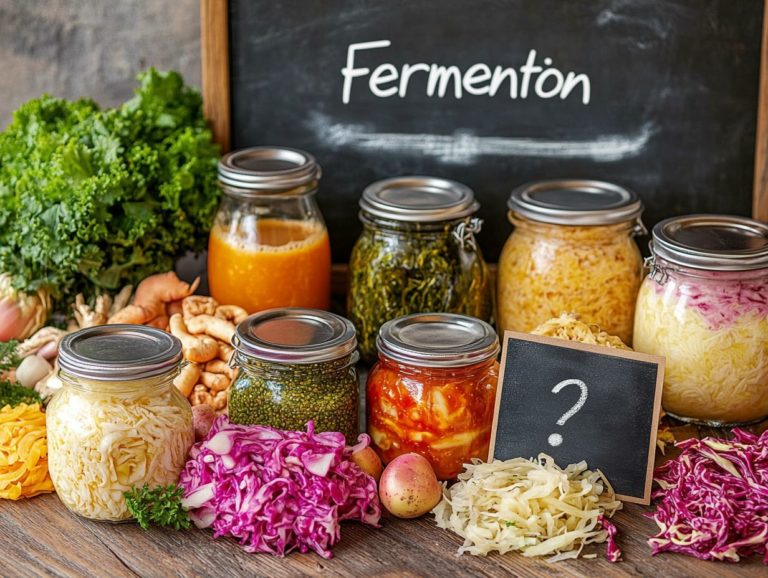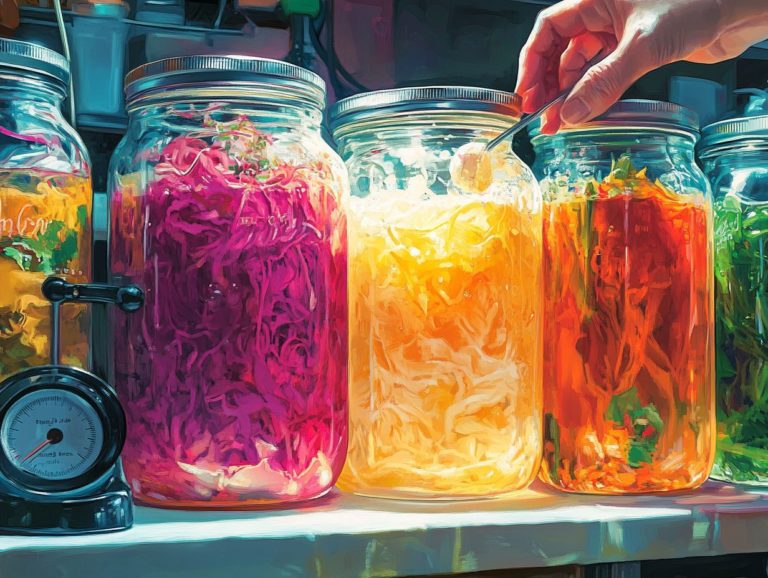Fermentation Profiles in Different Beer Styles
Contents
- Understanding the Art of Fermentation in Beer Brewing
- Key Takeaways:
- What Are the Key Factors in Fermentation for Different Beer Styles?
- 3. Fermentation Time
- 4. Adjunct Ingredients
- How Does Fermentation Affect the Flavor and Aroma of Beer?
- 1. Esters and Phenols
- What Are the Fermentation Profiles of Different Beer Styles?
- Frequently Asked Questions
- Factors Affecting Beer Fermentation
Understanding the Art of Fermentation in Beer Brewing
Fermentation lies at the very core of brewing, converting simple ingredients such as wort sugars into the rich and diverse array of flavorful beers you savor.
By grasping the key factors that influence fermentation such as yeast strains, temperature, and fermentation time you can elevate your brewing process to new heights, no matter your level of experience.
This article delves into how these elements shape the flavor and aroma profiles of various beer styles, spanning from ales to lagers and beyond, including distinct types like Stout, Porter, and Pilsner.
Uncover the intricate details of fermentation that create the unique characteristics defining each brew, and unveil the secrets to crafting the perfect pint.
Key Takeaways:
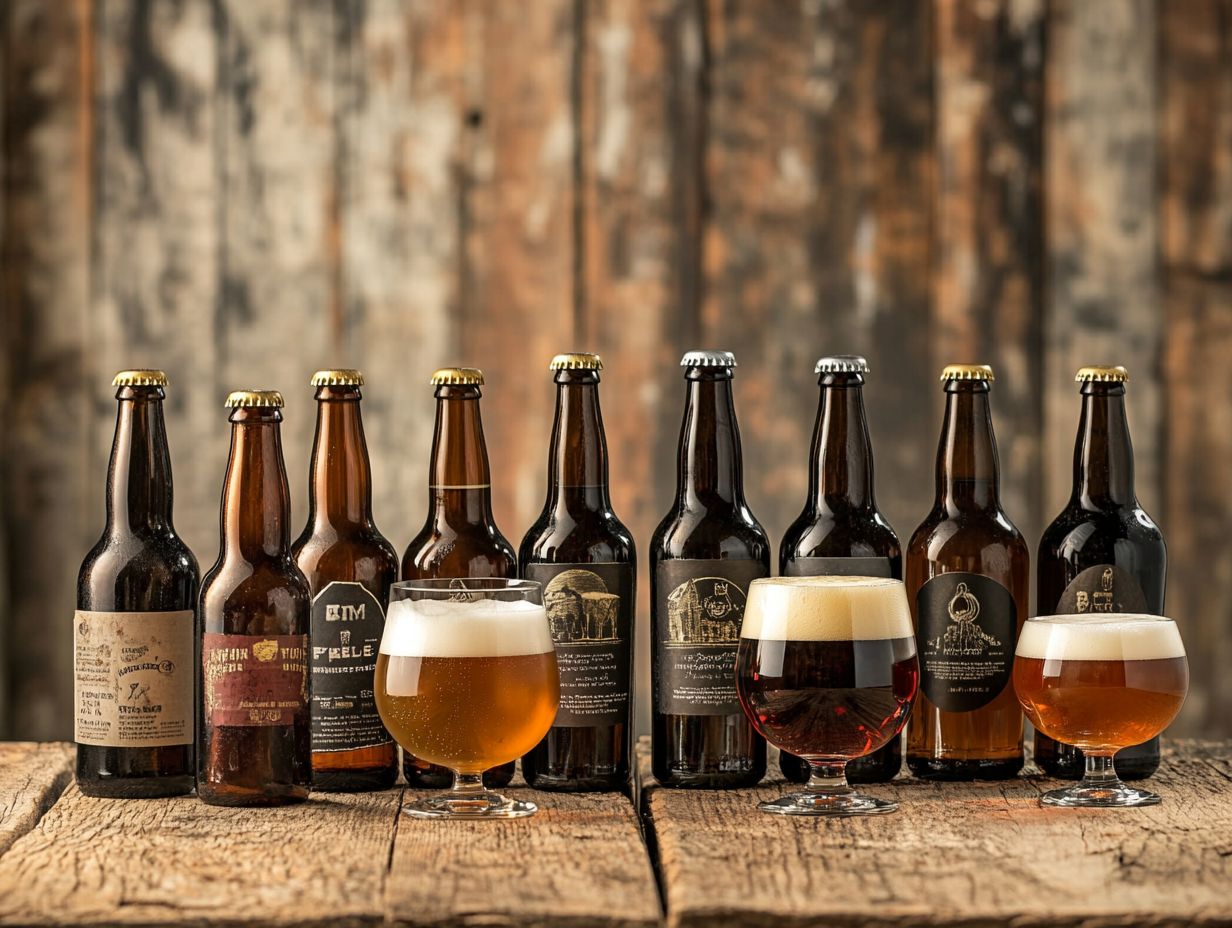
- Yeast strains play a crucial role in determining the unique fermentation profile of each beer style.
- Fermentation temperature and time greatly influence the flavor and aroma characteristics of different beer styles.
- Adjunct ingredients, such as fruits or spices, can also impact the fermentation process and contribute to the final taste of a beer.
What Are the Key Factors in Fermentation for Different Beer Styles?
The key factors in beer fermentation can vary considerably across different beer styles, shaping not only the brewing process but also the characteristics of the final product.
You’ll find that yeast strains are crucial, as they dictate the fermentation dynamics, including the active phase and lag phase. Yeast fermentation is a delicate process that requires careful monitoring of these stages.
Fermentation temperatures also play a significant role, impacting yeast health and the development of flavor compounds.
When you add in your choice of adjunct ingredients and the type of fermentation vessels used, it becomes clear that each stage of fermentation contributes to the distinct profile of ales and lagers.
By grasping these factors, you can effectively monitor fermentation activity and achieve the outcomes you desire in your brewing journey, navigating through brewing challenges and innovations.
1. Yeast Strains
Choosing the right yeast strains is essential for achieving the fermentation characteristics you desire in your beer. Different strains impart a variety of flavors, aromas, and alcohol content to your final product.
Each yeast strain possesses unique qualities that can significantly influence the outcome of your brewing process. For example, lager yeast ferments at cooler temperatures, providing a cleaner profile with fewer fruity esters. In contrast, ale strains thrive in warmer conditions, introducing complexity through a diverse array of flavor compounds.
Your selection of yeast also affects fermentation dynamics, dictating how quickly fermentation takes place and how effectively the yeast finishes fermentation. This ultimately impacts diacetyl levels, a crucial off-flavor that you ll want to control.
By understanding these nuances, you can effectively select specific strains to fine-tune your brewing techniques and achieve the beer characteristics you envision.
2. Fermentation Temperature
Fermentation temperature plays a pivotal role in your brewing journey, directly influencing yeast growth, fermentation dynamics, and ultimately shaping the flavor profile and quality of your beer.
Maintaining the ideal fermentation temperature is crucial for you as a brewer, as it determines how yeast converts sugars into alcohol and carbon dioxide throughout the fermentation process. If the temperature is too high, you risk producing off-flavors and unwanted compounds; too low, and fermentation could stall, leaving you with a sluggish brew.
Striking this balance is particularly vital during the various stages of fermentation, including both primary and secondary phases of beer fermentation.
Temperature fluctuations at this stage can dramatically alter the development of esters and phenols, which add complexity to your beer s character.
By dedicating careful attention to temperature control, you can profoundly impact your final product s aroma, mouthfeel, and overall drinkability, making it an essential consideration in your brewing process.
3. Fermentation Time
The duration of fermentation profoundly affects the development of flavor compounds and the overall maturation of your beer. It is crucial to monitor fermentation cycles carefully, paying attention to yeast growth and fermentation dynamics.
Consider the distinct characteristics of various beer styles ales, lagers, and stouts. Ales typically undergo a shorter fermentation period, resulting in vibrant, fruity aromas and layered flavors. Conversely, lagers require a more extended fermentation time, usually at cooler temperatures, to achieve that signature crisp and clean profile. Likewise, stouts thrive with longer fermentation, allowing rich flavors like chocolate and coffee to fully blossom.
As fermentation unfolds, yeast works its magic, converting sugars into alcohol and influencing the final alcohol content. This process highlights how both time and conditions are vital in crafting the unique characteristics that define each brew.
4. Adjunct Ingredients
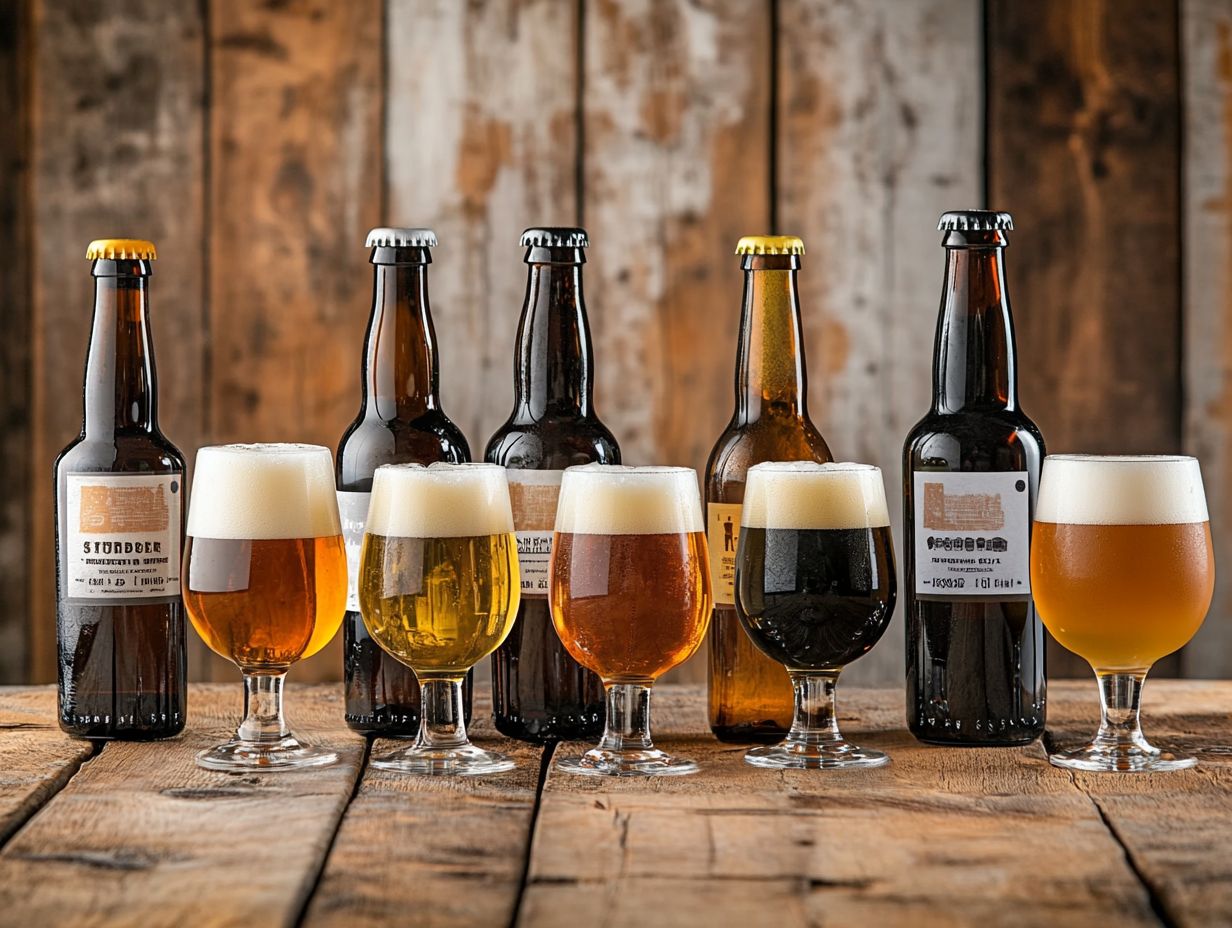
Adjunct ingredients, including additional sugars, spices, and flavorings, are your secret weapons for enhancing the complexity of your beer. Carefully integrating these elements during the brewing process contributes to a richer depth of flavor and influences fermentation dynamics.
When you introduce adjuncts like corn, rice, or even fruits, they interact with the primary sugars in the liquid extracted from the malted grains (wort), generating a variety of fermentable compounds. In traditional brewing practices, particularly those found in Belgian beers, spices such as coriander or orange peel layer in additional flavors that beautifully complement the yeast s natural esters. This meticulous balance enables you to adjust the mouthfeel, aroma, and overall alcohol content of the final product.
The interplay between these adjunct ingredients and the yeast opens the door to a remarkable range of unique sensory profiles. This showcases the artistry at the heart of brewing and the craft beer revolution!
How Does Fermentation Affect the Flavor and Aroma of Beer?
Fermentation is vital in crafting the rich flavor and aroma profiles of beer. The unique dynamics of fermentation produce a variety of flavor compounds, each contributing to the distinctive characteristics that define different beer styles.
By understanding this intricate process, you can truly appreciate the artistry behind every brew, which is a testament to brewing science and the dedication of the brewing community.
1. Esters and Phenols
Esters bring delightful fruity notes, while phenols add spicy aromas. These compounds elevate your brew to new heights! Both are affected by fermentation conditions and brewing techniques.
These compounds emerge from various metabolic processes as different yeast strains engage with sugars and other substrates. For example, certain yeast strains produce higher levels of esters when fermented at warmer temperatures, resulting in vibrant tropical fruit flavors that tantalize the palate. Conversely, cooler fermentation temperatures can yield fewer esters, leading to a more understated aromatic profile.
The production of phenolic compounds is equally influenced by the yeast type and the fermentation conditions you choose. Some strains flourish in specific environments, encouraging distinctive spicy notes that enhance the complexity of your final product. As a brewer, you must thoughtfully consider your yeast selection and fermentation conditions to craft the flavor experience you desire.
2. Diacetyl
Diacetyl is a byproduct of yeast’s fermentation that can create those unwanted buttery flavors if you don t keep it in check during the brewing process.
This compound forms when yeast undergoes its metabolic processes, especially in the early stages of fermentation when they’re busy producing amino acids the building blocks of proteins and other compounds.
If your brewing conditions aren t just right, the yeast might have a tough time fully converting this byproduct into less flavorful substances. This can result in that notorious buttery taste that can ruin an otherwise perfect batch of beer. To mitigate the risk of diacetyl, it s essential to monitor your fermentation processes carefully.
Ensure yeast health through proper oxygenation, temperature control, and nutrient availability. These are critical aspects of fermentation control.
Keep your yeast healthy, and your beer s flavors will shine! By maintaining robust yeast populations and providing optimal fermentation conditions, you can significantly reduce the unwelcome presence of diacetyl, preserving the intended flavors and aromas of your beer.
3. Sulfur Compounds
Sulfur compounds can emerge during fermentation and significantly impact the overall flavor profile of your beer, often leading to unpleasant aromas if not handled with care. Effective brewing tips can help manage these compounds.
- Hydrogen sulfide: Can introduce a rotten egg aroma, usually unwelcome in lagers.
- Sulfur dioxide: Can affect the freshness and stability of the beer.
- Dimethyl sulfide: May add sweet corn-like notes that can actually be appealing in certain ales.
To minimize these effects, consider using techniques like precise temperature control and choosing yeast strains that are less likely to produce sulfur. Adopting advanced fermentation practices is also beneficial.
By doing so, you ensure that the unique traits you desire in your beer shine through, making the final product both memorable and enjoyable.
4. Carbon Dioxide
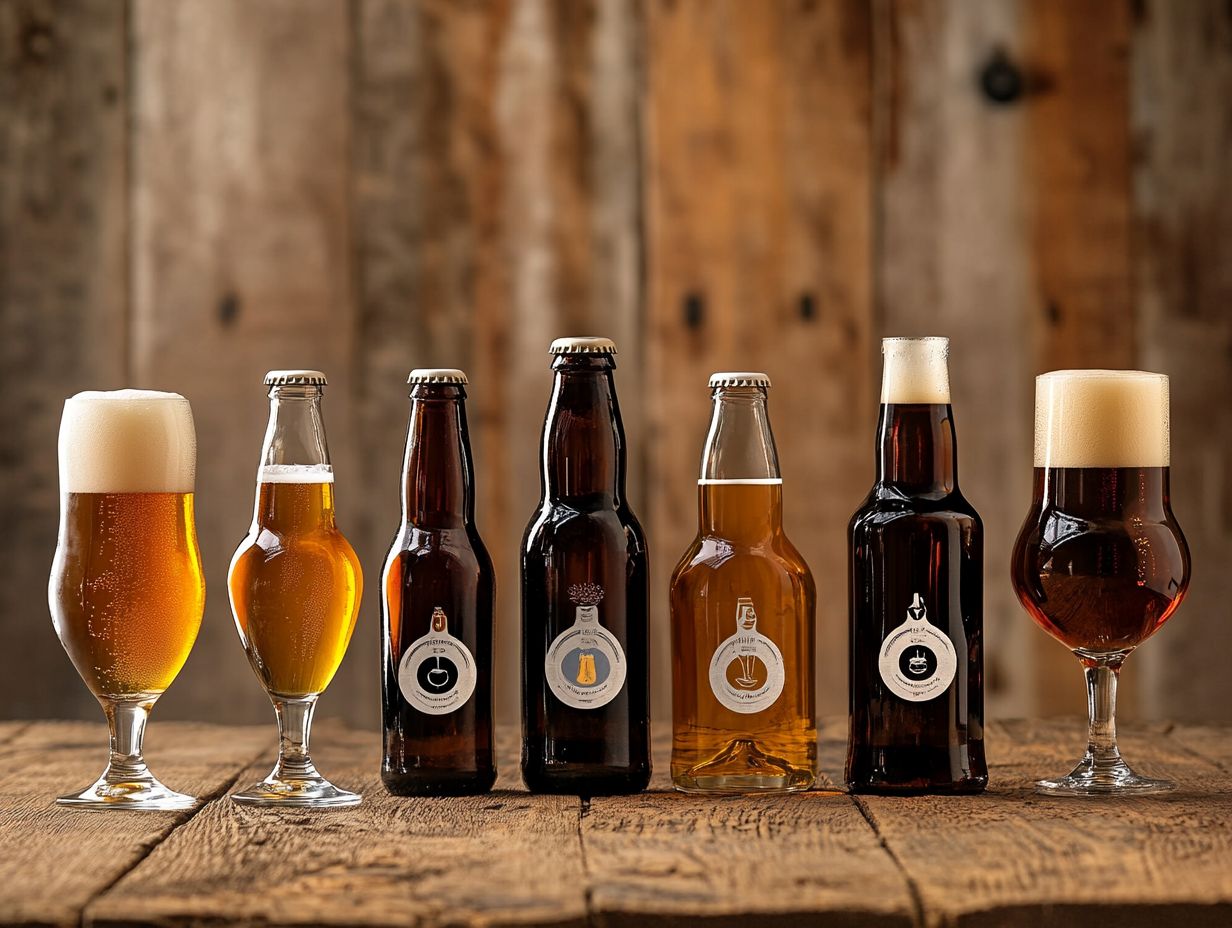
Carbon dioxide, a natural byproduct of fermentation, is essential in the beer maturation process, contributing to both carbonation and the overall mouthfeel.
During fermentation, yeast converts sugars into alcohol while simultaneously producing CO2 and a range of secondary metabolites that shape the beer s flavor and aroma profile. This effervescent gas is crucial; it elevates the sensory experience by delivering a delightful prickling sensation on your palate and enhancing the perception of certain flavors, often softening any harsher notes.
By carefully controlling fermentation conditions such as temperature and yeast strain you can ensure CO2 production aligns perfectly with the desired characteristics of the beer. This allows you to craft beverages that are both balanced and enjoyable.
Ultimately, grasping and managing the role of carbon dioxide throughout this process is vital to achieving the perfect final product. Act now to perfect your brewing process and enhance every sip!
What Are the Fermentation Profiles of Different Beer Styles?
Grasping the fermentation profiles of various beer styles is crucial for you as a brewer.
Each style presents distinct fermentation characteristics that play a significant role in shaping the flavor, aroma, and mouthfeel of the final product.
1. Ale Styles
Ale styles are distinguished by their use of top-fermenting yeast strains, which thrive in warmer temperatures. This distinctive fermentation dynamic results in the creation of complex flavor compounds, setting ales apart from their lager counterparts that utilize bottom-fermenting yeast and cooler brewing conditions.
You ll find that the most popular ale styles, such as pale ales, stouts, and Belgian ales, offer a remarkable spectrum of flavors, all influenced by their unique fermentation processes.
For example, when you indulge in a pale ale, the use of Saccharomyces cerevisiae often brings forth delightful fruity and floral notes. In contrast, a Belgian dubbel may surprise you with its rich, fruity esters and spicy phenols, reflecting a brewing tradition that spans centuries.
By grasping these nuances, you not only enhance your appreciation of ales but also gain insight into the artistry behind brewing techniques that have evolved throughout history.
2. Lager Styles
Lager styles make use of bottom-fermenting yeast strains that thrive in cooler fermentation temperatures. This results in the clean, crisp flavors you ve come to expect from this category.
These fermentation profiles play a pivotal role in shaping the character of the beer. By maintaining lower temperatures, typically ranging from 45 F to 55 F, you slow down yeast activity. This allows for the development of those subtle, nuanced flavors that elevate your drinking experience.
Czech Lagers
In regions celebrated for their lager production, like the Czech Republic, brewers employ distinct techniques to enhance these qualities. For example, Czech lagers are famous for their smoothing and often benefit from an extended maturation phase.
German Styles
Meanwhile, German styles might feature varied hop additions that complement the yeast s refined profile. This results in a delightful array of refreshing and enjoyable brews.
3. Sour Styles
Sour styles of beer involve a fascinating fermentation process that incorporates wild yeast and bacteria. This results in distinct flavor profiles marked by tartness and complexity.
This journey often begins with the introduction of specific strains of Lactobacillus and Brettanomyces, which contribute to that signature sourness and depth of flavor. Many brewers embrace wild fermentation techniques, allowing the beer to evolve naturally over time.
This process unveils a delightful spectrum of unexpected notes, ranging from fruity to funky, keeping your taste buds engaged. Recently, the brewing community has seen a resurgence in interest in these styles.
Enthusiasts like you appreciate the intricate balance of flavors achieved through careful fermentation practices and natural stabilization techniques. By nurturing a harmonious environment for these microorganisms, brewers can create sour beers that not only tantalize the palate but also showcase the artistry of traditional craftsmanship.
4. Specialty Styles
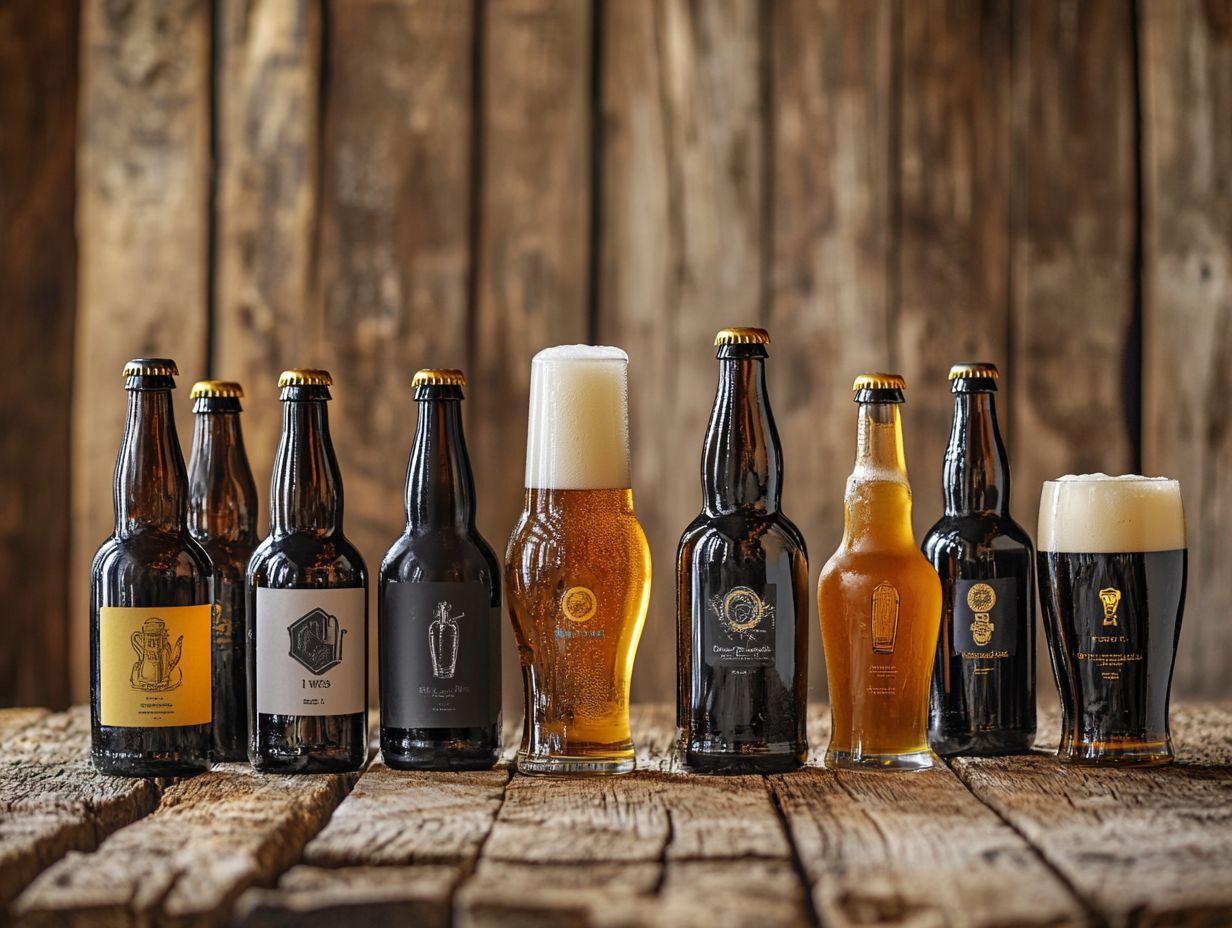
Specialty styles of beer often incorporate unique adjunct ingredients that add intriguing flavors and aromas. This results in a captivating array of fermentation characteristics.
These innovative brewing techniques can involve everything from exotic fruits and spices to alternative grains. Each contributes its own distinct character to the final product.
The fermentation process itself can be meticulously crafted to harness these adjuncts, producing complex flavor profiles that traditional methods may struggle to replicate. When wild yeast strains or barrel-aging techniques are thoughtfully integrated, they often blend seamlessly with the unique ingredients.
These exciting specialty styles are pushing flavor boundaries like never before, enticing both seasoned enthusiasts and casual drinkers alike.
Frequently Asked Questions
Here are some frequently asked questions about fermentation and beer styles.
What is fermentation and how does it affect different beer styles?
Fermentation is the process by which yeast converts sugars into alcohol and carbon dioxide. Different beer styles use different types of yeast and fermentation temperatures, resulting in unique flavor profiles.
What are some common beer styles and their corresponding fermentation profiles?
Some common beer styles and their fermentation profiles include lagers, which are fermented at cooler temperatures for longer periods, resulting in a clean and crisp taste. Ales are fermented at warmer temperatures for shorter periods, resulting in a more robust and fruity taste.
How does the type of yeast used affect the fermentation profile of beer?
The type of yeast used greatly influences the fermentation profile of beer. Different strains of yeast produce different flavors and aromas, resulting in a wide range of beer styles and characteristics.
Can the fermentation profile of a beer be changed by altering the temperature?
Yes, the temperature at which the beer is fermented can greatly impact its profile. Lower temperatures result in a slower fermentation process and a cleaner taste, while higher temperatures can produce more complex and intense flavors.
Factors Affecting Beer Fermentation
Impact of Time and Oxygen
Time and oxygen exposure significantly influence beer fermentation. Longer fermentation creates more complex flavors, while contact with oxygen can lead to unpleasant tastes and lower quality.
Unique Profiles for Beer Styles
Many beer styles have unique fermentation profiles. For instance, Belgian beers often use special yeast strains, offering a delightful range of complex flavors.
Sour beers undergo a secondary fermentation with bacteria, which gives them a tart and refreshing taste that many people enjoy.

